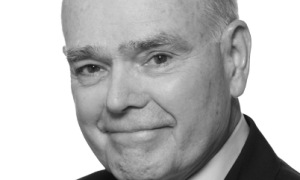In January 1990, two months after the Berlin Wall fell, I was discussing world politics over brunch with my wife, Anne, and daughter Elizabeth. We were unpleasantly surprised that, despite the end of communism in Eastern and Central Europe and the prospects for freedom in the Soviet Union, few people seemed interested in discussing the manifold crimes of communism. A general amnesia, even in some of the former communist countries, seemed to be setting in.
Knowing that those who fail to remember history tend to repeat it, we determined to memorialize the victims of communism.
Thus was born the idea that became Washington's newest memorial, located on Capitol Hill at the intersection of Massachusetts Ave., N.W., New Jersey Ave., and G St., N.W. an international memorial to the more than 100 million victims of communism (a number documented by The Black Book of Communism, published by the Harvard University Press).
Of course, a memorial doesn't spring up overnight. It took several years to get the ball rolling -- until December 1993 -- when President Bill Clinton and Russian President Boris Yeltsin scheduled a summit meeting. Before the meeting, Clinton gave Congress the Friendship R-US Act. The bill authorized the design and construction of a memorial in Washington to the victims of communism, and unanimously passed Congress as Public Law 103-199.
But the law also stated that "no federal funds" could be spent on the "establishment" of the memorial. The organizers would have to rely on non-governmental financial support from individuals, foundations and corporations, although the law did not prohibit seeking funds overseas.
Over the next two years, the Victims of Communism Memorial Foundation was incorporated, a board of directors was elected with Lev Dobriansky as chairman and me as president. We became a tax-exempt organization and started trying to raise money.
In the spring of 1995, Dobriansky and I met for the first time with John Parsons, a senior official of the National Park Service. Parsons has overseen the creation of Washington memorials and monuments for 30 years.
Parsons gave us a memorandum outlining the "Steps for Establishing a Memorial in the Nation's Capital" from legislation, site selection and approval, and design approval to fundraising and construction. There were 24 separate steps to be negotiated. As we prepared to leave his office, Parsons said quietly, "It's going to take longer than you think."
The Foundation decided to raise its public profile by initiating an annual awards event at which a Truman-Reagan Medal of Freedom would be given to an individual (or organization) in America or abroad who had demonstrated life-long opposition to communism and support of freedom and democracy.
The award was named after Harry Truman and Ronald Reagan because the Cold War started during the presidency of the former and effectively ended during the presidency of the latter. The first winners were Elena Bonner and the late Lane Kirkland.
The Foundation shifted into high gear. The National Park Service said it would be happy to help the Foundation find an appropriate site for the Memorial. Donors reacted favorably to the proposed $1 million Memorial. Ethnic communities stepped up their participation, led by the Vietnamese Americans in Northern Virginia, followed by the Latvians, Estonians and Lithuanians. President George W. Bush became honorary chairman.
But, we wondered, what should the Memorial look like? After months of discussion and debate, the Foundation's board of directors unanimously selected the Democracy statue erected by Chinese students in the spring of 1989 as the core of the Memorial.
This statue was selected because it recalls the Tiananmen Square massacre and the continuing communist oppression in the world's most populous country (which has had the largest number of victims). Plus, it was based on the Statue of Liberty a global symbol of freedom and democracy.
Following presentations by us, the National Capital Planning Commission approved the site and the Commission of Fine Arts approved the design -- despite Communist China's protests to administration officials and the National Park Service
The "only" thing that now remained for the Foundation to do was to raise the necessary funds. We had roughly half of what we'd need, and convinced companies including Pfizer, Lockheed Martin and Phillips International, and foundations like The Heritage Foundation, Pew Charitable Trusts, the Fund for American Studies, Young America's Foundation, Earhart and Shelby Cullom Davis to pitch in.
We eventually raised $950,000.
The official groundbreaking of the Memorial took place on Sept. 27, 2006, and it was completed and ready to be dedicated by June 12. Experts agree that no memorial has been built in a shorter period of time, and yet we're proud to have maintained the highest professional standards.
The dedication of this memorial means there will be a permanent reminder of the more than 100 million victims of communism. This day is, as every day ought to be, a day to remember those brave men and women who resisted communism and led the free world to victory in the Cold War and to the demise of the Soviet Union. And it is a day of resolution, as we resolve that never again shall we allow so evil a tyranny to terrorize the world.
Lee Edwards, Ph.D.,is the distinguished fellow in conservative thought at The Heritage Foundation.
First appeared in Human Events online

